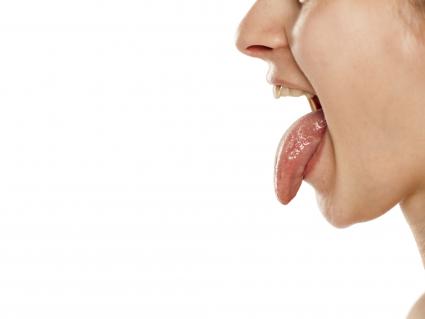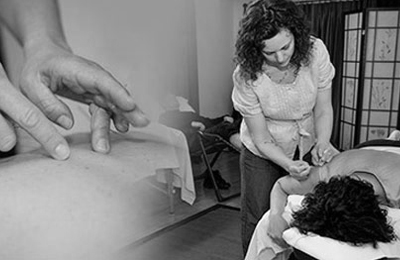Tongue and Pulse Reading According to Chinese Medicine

Have you ever wondered why your acupuncturist looks at your tongue and feels your pulse?
Practitioners of Chinese medicine learn and hone very specific and detailed ways of examining a patient in order to gather information to form a diagnosis. In the instance of Lyme disease and other tick borne diseases (TBDs), a Chinese medical practitioner will approach the patient from a unique perspective and diagnose according to underlying patterns concluded after what are called the four examinations.
The four examinations are: 1) looking, 2) touching, 3) asking, and 4) listening and smelling (in Chinese these are one word). Each one allows the acupuncturist to focus on different ways of recognizing signs that point to different disharmonies. This recognition initiates treatment using various acupuncture points and/or herbs in order for healing to take place.
Looking at the tongue and feeling the pulse are often considered the most important. When looking at a patient, an acupuncturist is observing the general appearance, physical shape, facial color and features, and the tongue—all as insights into the state of health from vibrancy to illness. Subtle nuances are observed that contribute to an interpretation of what is going on within the body and mind.
The tongue is one of the microcosms of the body that is like a mirror or map to the rest of the body. As the beginning of the digestive tract it can reflect the state of the gut, such as food intolerances, toxins, weak or overly taxed digestion and more. More than just digestion, certain parts of the tongue correspond to different organs, for example the far back of the tongue represents the kidneys and the very tip represents the heart, and depending on what is seen there, associations are made to different imbalances. For example, if the tip of the tongue has lots of very red dots, the patient may have anxiety or difficulty sleeping, and may feel hot at night.
When looking at the tongue, the overall body, shape, color, coat and texture are observed. A normal tongue is pale red with a thin white and somewhat moist coat. Deviations from this normal picture are a tongue that is very puffy, thin, or cracked; color that is very red, pale, purple or even more rarely black; coating that is very thick or non-existent (called peeled), yellow or even green, sticky, watery, or dry; a tongue that shakes, is stiff, does not extend easily or hangs too far. All of these are signs that point to underlying conditions. For example, a very red tongue with a yellow coat indicates much heat maybe from infection or inflammation, a pale and thin tongue with a dry coat can indicate deficient blood or body fluids, a purple color can indicate pain, a puffy tongue with scalloped edges from pushing out against the teeth indicates a weakness in overall Qi or excess fluids. A very thick coat can be described as greasy and indicated excess mucus or dampness in the body.
Of the four examinations, touching includes feeling the skin for heat, cold, dryness, moisture, if pain feels better or worse with touch, sensation at different acu-points, and most importantly, feeling the pulse. Just like the tongue, a lot of information can be gathered by nuances in the pulse. The pulse indicates overall health and strength of energy. Although rate is noted if it is abnormally fast, slow, or irregular, what an acupuncturist tunes into otherwise is overall quality of the pulse as in strength, width, shape, depth, length and more. The pulse is felt at three levels of pressure—superficial, middle, and deep. Three fingers are used at a specific location on both wrists with 2 different organs corresponding to each position, so 12 total. There are about 28 different pulse qualities, so it takes many years of practice and refinement to be able to identify these subtleties. There is a sensitivity of the practitioner for the overall quality of the pulse, as well as any difference felt between the right and left wrist and under each of the fingers. So, for example the liver position may feel quite different than the lung position, or if one organ was noticeably weaker than the rest that may indicate something problematic in that organ system.
A normal pulse is considered moderate in rate, it “is elastic and ‘lively,’ neither hard or unyielding nor flaccid and indistinct.” If the pulse is weak without force, it can indicate some kind of depletion. Although it is normal for a woman to have a softer pulse than a man, for an athlete to have a slower pulse and for children to have a faster pulse, for a heavier set person to have a deeper pulse and for a thinner person to have a more superficial and even ‘thin’ pulse. Examples of quality of pulses and what they point to as far as potential diagnosis are—a ‘floating’ pulse (felt very superficially) can indicate the body trying to fight off an illness coming from the outside as in a viral cold or flu or initial Lyme or TBD infection, whereas a very deep and weak pulse can indicate a more chronic internal illness when the patient feels debilitated, a ‘wiry’ pulse (hits the fingers like a taut guitar string) can indicate pain and/or emotional stress, a ‘slippery’ pulse (rolls or glides under the fingers) can indicate phlegm in the body, and is also a normal pulse during pregnancy.
The beauty of Chinese medicine is that it is a unique comprehensive system of health care with a continuous clinical tradition of over 3,000 years with documented research and practice, and it is also a sophisticated art. Tongues and pulses vary from each individual to the next and will change over time, often even within an acupuncture treatment. When all the pieces are gathered by getting to know the patient as a unique individual, a treatment is formulated using the science of medicine and the art of healing.
References:
Kaptchuk, Ted. The Web That Has No Weaver, Understanding Chinese Medicine.
Maciocia, Giovanni. The Foundations of Chinese Medicine: A Comprehensive Text for Acupuncturists and Herbalists.





















